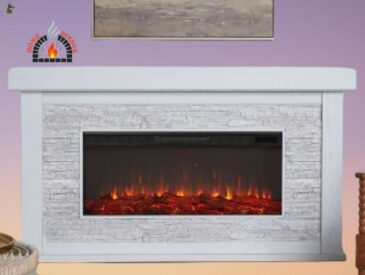How to Safeguard Your Entertainment Setup
Having a TV mounted above a fireplace is a popular design choice in modern homes, adding both style and functionality. Yet, a crucial consideration arises:
can an electric fireplace potentially harm your television?

While this scenario is possible when the heat is directed towards the TV, most electric fireplaces disperse heat through the glass front or towards the base. Moreover, maintaining a minimum clearance of 18 inches ensures your fireplace won’t pose a threat to your TV.
Thankfully, there are effective measures to safeguard your TV from heat damage, even if your unit emits heat upward. In this article, we’ll detail strategies to shield your TV from potential harm and discuss the recommended spacing between the two appliances.

Can an Electric Fireplace Damage a TV?
Electric fireplaces with top heaters and blowers do pose a risk to your TV. To mitigate this risk, consider installing a mantel or positioning the TV with a minimum of 18 inches of clearance.
When the blower is located on the sides or bottom of the fireplace, a clearance of 6 – 10 inches suffices for safety.
Notably, certain electric fireplaces do not emit heat, eliminating concerns of damage. However, given that a heated electric fireplace can potentially harm TVs, it is imperative to take precautions to protect your television from both damage and fire hazards. Below are three steps you can implement to shield your TV from the fireplace’s heat:

1. Shield with a Mantel: A mantel serves as an effective solution to safeguard your TV from heat-related damage. It acts as a barrier, preventing direct heat exposure and safeguarding the electronics.
Additionally, a mantel introduces a practical design element, breaking up the visual space between the fireplace and the TV. Many mantels also offer an additional shelf, providing both protection and an opportunity for creative expression.

2. Optimal Distance for Hanging the TV: Maintaining a safe distance between the TV and the fireplace is crucial to prevent damage. As a general guideline, install the TV at least 18 inches above the top of the fireplace.
While consulting your user manual for manufacturer recommendations is advisable, 18 inches is typically sufficient. For added peace of mind, you can opt for a greater clearance.
3. Redirect Heat with a Deflector: A deflector, typically installed beneath a mantel, redirects heat into the room, shielding both the mantel and TV from direct heat damage. Additionally, a deflector enhances the efficiency of the fireplace.

Overall, electric fireplaces tend to emit less heat compared to wood-burning or gas fireplaces, rendering them a safer and more cost-effective option. Generally, electric fireplaces are unlikely to pose a threat to your television:
- Not all electric fireplaces produce heat.
- Most electric fireplace models disperse heat via the glass front.
- With a minimum clearance of 18 inches, an electric fireplace maintains a safe distance from the television.
How Close Can a TV Be to an Electric Fireplace?
In most cases, it is safe to install a TV 6 – 10 inches from the top of an electric fireplace. However, if the fireplace employs a top heater that emits heat upwards, the recommended clearance increases to 18 inches above the top of the fireplace.

The recommended clearance depends on the functioning of your electric fireplace. Fireplaces that do not generate heat require no clearance as there is no heat output to pose a risk to the TV.
To determine the optimal clearance, assess the location of the heater and blower:
- A bottom or side heater/blower presents a lower heat risk, necessitating 6 – 10 inches of clearance.
- In the case of a top heater, ascertain the direction of airflow. Fireplaces directing hot air outwards still require 6 – 10 inches of clearance, while those blowing heat upwards demand 18 inches of clearance to prevent overheating.

Ensuring TV Resilience to Heat: Consider the heat tolerance of your TV as you determine the appropriate clearance. While heat resistance varies by brand, most TVs can withstand temperatures between 100 – 140 degrees Fahrenheit.
Temperatures exceeding the recommended range can lead to electrical failure and damage. Additionally, check your TV’s warranty requirements, as some manufacturers may void warranties for TVs mounted above fireplaces.
Is an Electric Fireplace Noisy?: Electric fireplaces are generally quiet, except for the blower when activated. The blower, responsible for circulating warm air, produces some noise, though it remains within acceptable levels. Excessive noise from your fireplace may indicate a malfunction that requires attention.

Typically, electric fireplaces do not produce significant noise, ensuring they do not disrupt your viewing experience. This especially holds for models that do not generate heat.
Most noise generated by electric fireplaces originates from the blower, a small fan dispersing warm air into the room. If there is no heat to disperse, a blower is unnecessary. For models that do produce heat, two types exist: infrared electric fireplaces and electric coil fireplaces.
Electric Coil Fireplace: These units function akin to space heaters, generating heat through extremely hot coils. A fan distributes the heated air into the room, resulting in some operational noise. However, it is possible to use these fireplaces without activating the heat, ensuring a noise-free operation.
Infrared Electric Fireplaces: These fireplaces rely on light technology to heat a room, eschewing the need for heating coils and fans. While some infrared heaters feature internal fans to maintain optimal temperatures, the associated noise is minimal, comparable to the fans in a PC.
Due to their quiet operation, an infrared electric fireplace will not overpower your TV’s sound.
Choosing the Right TV Size for Your Fireplace: A balanced visual appeal is achieved when the width of the fireplace slightly exceeds that of the TV.
Furthermore, similar heights between the television and fireplace create a harmonious aesthetic. While personal taste plays a role, adhering to some guidelines can enhance the room’s overall appearance.

Mismatched sizes between the TV and fireplace can disrupt the room’s balance. Mounting a TV too high, necessitated by fireplace clearance, can lead to an awkward viewing angle. This issue is less likely with electric fireplaces, as their lower clearance reduces such concerns compared to wood-burning or gas fireplaces.
An excessive gap between the fireplace and TV can also result in visual imbalance, particularly with wide and short linear electric fireplaces. Proportional considerations are paramount to achieving a pleasing visual harmony.
When the TV screen greatly exceeds the fireplace’s width, a top-heavy appearance can arise. Conversely, a significantly wider fireplace can create a bottom-heavy look.

Opting for a fireplace slightly wider than the TV ensures an aesthetically pleasing balance. In cases where the TV surpasses the fireplace’s width, a fireplace surround can effectively address the discrepancy.
Certain challenges with proportionality may arise with linear electric fireplaces, given their wide yet short dimensions. To restore balance, consider repositioning the TV or utilizing shelves and decor to harmonize the space.
In summary, maintaining proportionate dimensions between your TV and fireplace is key to achieving a visually appealing layout.
By implementing these precautions and considering the recommended clearances, you can ensure a safe and aesthetically pleasing integration of your electric fireplace and TV in your living space.




